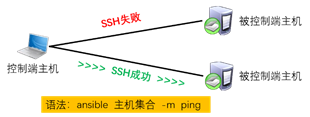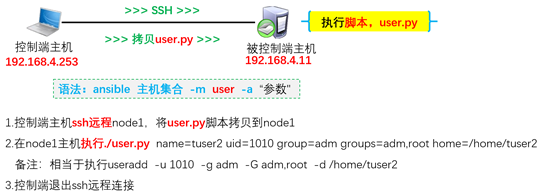Ansible 介绍与安装
目录
Ansible的定义
ansible是一种自动化运维工具,基于paramiko开发的,并且基于模块化工作,Ansible是一种集成IT系统的配置管理、应用部署、执行特定任务的开源平台,它是基于python语言,由Paramiko和PyYAML两个关键模块构建。集合了众多运维工具的优点,实现了批量系统配置、批量程序部署、批量运行命令等功能.ansible是基于模块工作的,本身没有批量部署的能力.真正具有批量部署的是ansible所运行的模块,ansible只是提供一种框架.ansible不需要在远程主机上安装client/agents,因为它们是基于ssh来和远程主机通讯的.
Ansible的基础架构
ansible系统由控制端和被控端组成,控制主机不支持windows平台

| 名字 | 含义 |
|---|---|
| Ansible | Ansible核心程序 |
| HostInventory | 记录由Ansible管理的主机信息,包括端口、密码、ip等 |
| Playbooks | “剧本”YAML格式文件,多个任务定义在一个文件中,定义主机需要调用哪些模块来完成的功能 |
| CoreModules | 核心模块,主要操作是通过调用核心模块来完成管理任务。 |
| CustomModules | 自定义模块,完成核心模块无法完成的功能,支持多种语言。 |
| ConnectionPlugins | 连接插件,Ansible和Host通信使用 |
Ansible的程序目录结构
- 配置文件:/etc/ansible/
- 执行文件目录:/usr/bin/
- lib依赖库:/usr/lib/python3.6/site-packages/ansible/
- help文件:/usr/lib/python3.6/site-packages/ansible/
Anisible特性
- 模块化
- 有Paramkio(基于SSH),PyYAML(语言,实现playbook),jinja2(模块语言)三个关键模块
- 支持自定义模块
- 幂等性:执行一次和执行多次的情况一样,如果发现已经执行过,不会执行第二次。
- 支持playbook编排任务
- 无需代理不依赖PKI(无需SSL)
- 安全,基于OpenSSH
- 部署简单,只需要python,SSH,agentless
注意事项
- 执行ansible的主机成语主控端,中控,master或者堡垒机
- 主控端python版本需要2.6或者3.5以上
- 被控端如果python版本小于2.4需要安装python-simplejson
- 被控端如果开启seLinux,需要安装libselinux-python
- windows不能作为主控端。
安装Ansible
[root@localhost ~]# yum install -y ansible
总下载量:22 M
安装大小:124 M
Downloading packages:
(1/22): PyYAML-3.10-11.el7.x86_64.rpm | 153 kB 00:00:00
(2/22): libyaml-0.1.4-11.el7_0.x86_64.rpm | 55 kB 00:00:00
(3/22): python-backports-1.0-8.el7.x86_64.rpm | 5.8 kB 00:00:00
(4/22): python-backports-ssl_match_hostname-3.5.0.1-1.el7.noarc | 13 kB 00:00:00
(5/22): python-cffi-1.6.0-5.el7.x86_64.rpm | 218 kB 00:00:00
......
完毕!
自定义清单(配置组内成员)
需要编辑ansible.conf中的inventory,到新的文件中。此后只修改新增的文件即可。
[root@localhost ansible]# cp hosts inventory
[root@localhost ansible]# vim inventory 此后只需编辑inventory
[test]
192.168.190.133 ansible_password=123456
192.168.190.134 ansible_password=123456
192.168.190.135 ansible_password=123456
ansible ip/组名 --list-hosts 查看组内或者某个对象的信息
[root@localhost ansible]# ansible test --list-hosts 查看test组内的主机信息
hosts (3):
192.168.190.133
192.168.190.134
192.168.190.135
Anisble实现管理方式
-
Ad-Hoc:即ansible命令。临时使用场景。
格式:ansible 主机集合 -m 模块名 -a "参数"
-
Asible-playbook:主要用于长期规划好的,大型项目的场景,需要有前提的规划。
Ansible常用模块
ping 模块
Ansible最基础的模块是ping模块,主要用于判断远程客户端是否在线,用于ping本身服务器

密码认证:
- 方法1:-k输入密码
- 方法2:inventory中写入密码
[root@localhost ansible]# ansible 192.168.190.135 -m ping -k 方法1:-k 然后输入登录密码即可。
SSH password:
192.168.190.135 | SUCCESS => {
"ansible_facts": {
"discovered_interpreter_python": "/usr/bin/python"
},
"changed": false,
"ping": "pong"
}
[root@localhost ansible]# vim /etc/ansible/inventory
[test]
192.168.190.133 ansible_password=123456 方法二:主机清单中添加password。也可指定用户名
192.168.190.134 ansible_password=123456
192.168.190.135
[root@localhost ansible]# ansible all -m ping 3台被控机都已ping通。
192.168.190.135 | SUCCESS => {
"ansible_facts": {
"discovered_interpreter_python": "/usr/bin/python"
},
"changed": false,
"ping": "pong"
}
192.168.190.134 | SUCCESS => {
"ansible_facts": {
"discovered_interpreter_python": "/usr/libexec/platform-python"
},
"changed": false,
"ping": "pong"
}
192.168.190.133 | SUCCESS => {
"ansible_facts": {
"discovered_interpreter_python": "/usr/libexec/platform-python"
},
"changed": false,
"ping": "pong"
}
user 模块
实现Linux系统账户管理

ansible 192.168.190.133 -m user -a 'name=tom uid=5000 state=present/absent'
present:表示存在状态(默认状态)
absent: 表示缺席状态
[root@localhost ansible]# ansible 192.168.190.133 -m user -a 'name=sawyer' 133主机上创建sawyer用户
192.168.190.133 | SUCCESS => {
"ansible_facts": {
"discovered_interpreter_python": "/usr/libexec/platform-python"
},
"append": false,
"changed": false,
"comment": "",
"group": 1000,
"home": "/home/sawyer",
"move_home": false,
"name": "sawyer",
"shell": "/bin/bash",
"state": "present",
"uid": 1000
}
[root@localhost ansible]# ansible 192.168.190.133 -m user -a 'name=sawyer state=absent' 状态为absent,表明把sawyer这个用户从133的主机上删除掉。
192.168.190.133 | CHANGED => {
"ansible_facts": {
"discovered_interpreter_python": "/usr/libexec/platform-python"
},
"changed": true,
"force": false,
"name": "sawyer",
"remove": false,
"state": "absent"
}
command/raw/shell 模块
注:Anisble默认模块为command
在被控端执行任意命令
| 模块名 | 说明 |
|---|---|
| command | 无法使用环境变量等 |
| raw | 无需被控主机安装python,用于被主机设备(网络设备等) |
| shell | 可使用管道符,重定向等 |
[root@localhost ansible]# ansible 192.168.190.133 -a 'ls' command查看
192.168.190.133 | CHANGED | rc=0 >>
anaconda-ks.cfg
[root@localhost ansible]# ansible 192.168.190.133 -m shell -a 'echo "你好" > file1.txt' 引用shell模块新建file1文件
192.168.190.133 | CHANGED | rc=0 >>
[root@localhost ansible]# ansible 192.168.190.133 -m shell -a 'ls' 查看,发现已经新增
192.168.190.133 | CHANGED | rc=0 >>
anaconda-ks.cfg
file1.txt
script 模块
会把-a后面的脚本拷贝到被管理端主机,然后执行这个脚本

[root@localhost /]# mkdir scripts
[root@localhost /]# ls /scripts/
test.sh
[root@localhost /]# chmod u+x scripts/test.sh 给脚本添加执行权限。
[root@localhost scripts]# vim /scripts/test.sh 编写脚本
#!/bin/bash
echo "hello world"
成功在133主机上执行test.sh脚本
[root@localhost scripts]# ansible 192.168.190.133 -m script -a '/scripts/test.sh'
192.168.190.133 | CHANGED => {
"changed": true,
"rc": 0,
"stderr": "Shared connection to 192.168.190.133 closed.
",
"stderr_lines": [
"Shared connection to 192.168.190.133 closed."
],
"stdout": "hello world
",
"stdout_lines": [
"hello world"
]
}